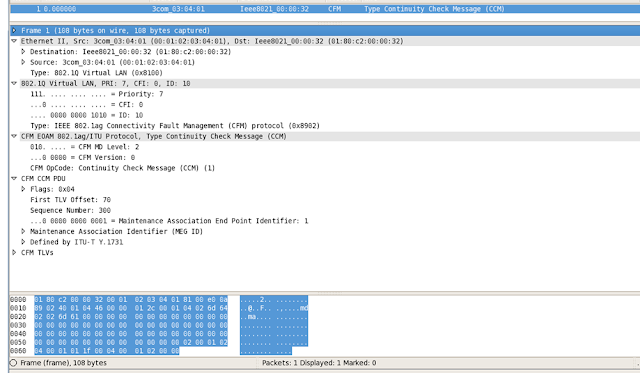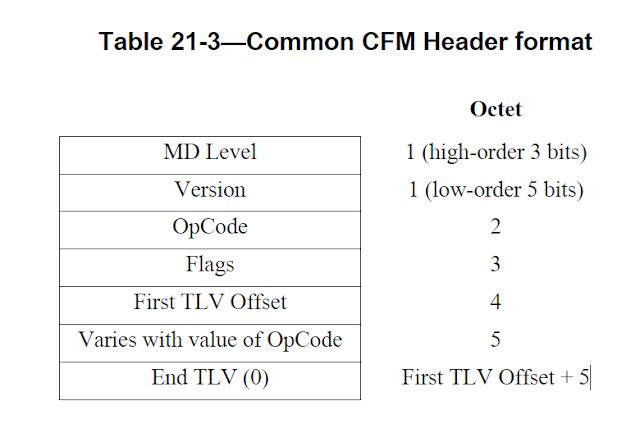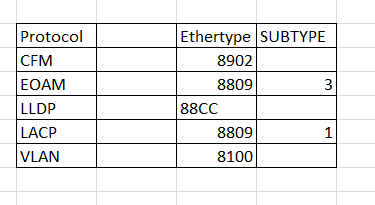CFM PKT FORMAT:

CCM format:

CFM HEADER FORMAT:

CFM LEVEL:

CFM MAID:

CFM OPCODE:

CCM FLAGS:

CFM TLV'S:

CFM VS Y1731:

DESTINATION MAC ADDRESS:


LBM FLAGS:

LBM PDU:

LBM TLV:

LBR TLV:
LTM FLAGS:

CFM PDU:

CCM format:

CFM HEADER FORMAT:

CFM LEVEL:

CFM MAID:

CFM OPCODE:

CCM FLAGS:

CFM TLV'S:

CFM VS Y1731:

DESTINATION MAC ADDRESS:


LBM FLAGS:

LBM PDU:

LBM TLV:

LBR TLV:
LTM FLAGS:

CFM PDU:
Two sides of the MEP, active sap, passive sap.
· There are two state maching running in the each MEP. One is MEP CC receiver and another one is MEP CC initiator
· Active sap(incase of down mep) is facing towards the lan and passive sap facing towards the Frame filtering
· To know detail take four bridge and in which inner 2 bridge configured with level 3 and outer 2 brg configured with the level 5 and refer the section in dot1ag 19.2.4 MP Type Demultiplexer
· When frame received on the ACTIVE sap then if the frame equal to the correct level then given to MEP CC receiver and which in turn fills the MEP/MIP ccm DB.
· If the frame level of received on the Active SAP is greater then its MD level then frame will be given to passive sap (i.e frame filtering for forwarding).
· If the frame level of received frame is lower then Active SAP level then frame will be given to MEP CC receiver state machine(because this state machine only raise fault and give to FNG state machine) and then frame is discarded
· Also in the active side if the frame type not equal to the CFM type also will be given to passive SAP
· Another side of MEP is passive SAP. Here only the higher level frame only will be given to active side. i.e. will be forwarded to lan (in terms of the down mep). Even frame md level equal this frame will be discarded . because in passive side no frame will be expected. And lower md level packet also will be rejected.
· The MEP CC initiator state machine simply start timer and initiate the packet and given it to the active SAP side of the mep. If there is any fault present in this MA then RDI bit will be set accordingly and will be send to the remote MEP side.
· MAdefectIndication is the variable set by MEP CC receiver state machine and it will be set true if any of the following defect is true. ( That is, MAdefectIndication is true if and only if, for one or more of the variables someRDIdefect, someRMEPCCMdefect, someMACstatusDefect, errorCCMdefect, or xconCCMdefect )
o someRDIdefect – from any one of the RMEP sending CCM’s with RDI bit set then this variable will be true in remote mep state machine.
o someMACstatusDefect – based on the received port status tlv and interface status tlv (these tlv’s are part of the CCM pdu) it will be set. Port status tlv (i.e. irrespective of the physical interface up/down its indicating stp block /active) and interface status tlv ( physical interface down) is come from the remote MEP.
o someRMEPCCMdefect - True indicates that at least one of the Remote MEP state machines is not receiving valid CCMs from its remote MEP
o xconCCMdefect (DefXconCCM/UnexpectedMEG/
o errorCCMdefect (DefErrorCCM) - A Boolean flag indicating that erroneous CCMs are being received from some MEP in this- error ccm include Unexpected MEP (A MEP detects UnexpectedMEP when it receives a CCM frame with a correct MEG Level(i.e., MEG Level equal to the MEP's own MEG Level), a correct MEG ID but an unexpected MEP ID which includes the MEP's own MEP ID.) or Unexpected MEG Level (A MEP detects UnexpectedMEGLevel when it receives a CCM frame with incorrect MEG Level. Incorrect MEG Level is less than the MEP's own MEG Level.) or Unexpected Period (A MEP detects UnexpectedPeriod when it receives a CCM frame with a correct MEG Level (i.e., MEG Level equal to the MEP's own MEG Level), a correct MEG ID, a correct MEP ID, but with Period field value different than the MEP's own CCM transmission period.)
o so for the above 5 different errors can be detected when receiving the CCM from via MEP CC receiver state machine. For these 5 different defects will be reported to FNG fault alarm state machine. That FNG alarm state machine assigns the priority to these defect and classify which defect should be mentioned at the top. That classification is
o
Variable
|
highestDefectPri
|
Importance
| |||
xconCCMdefect
|
DefXconCCM
|
5
|
Most
| ||
errorCCMdefect
|
DefErrorCCM
|
4
| |||
someRMEPCCMdefect
|
DefRemoteCCM
|
3
| |||
someMACstatusDefect
|
DefMACstatus
|
2
| |||
someRDIdefect
|
DefRDICCM
|
1
|
Least
|
o MEP Fault Notification Generator state machine state machine start running based on the variable set by the MEP CC state machine. That variable is nothing but MAdefectIndication
o rMEPCCMdefect (Loss of continuity ) – it’s the variable maintained in the rmep state machine. Reports the state of the remote MEP. When true, no CCM has been received from the remote MEP for at
least (3.25 ∗ CCMtime(CCMinterval)) seconds.
o Other error not coming into fng state machine and based on CCM sequence number is : CCMsequenceErrors
· MEP CC Receiver
o Its maintain the 3 state machines along with MEP CC Receiver state machine
§ Remote MEP state machine
§ Remote MEP Error state machine
§ MEP Cross Connect state machine
o There are two procedure in MEP CC Receiver 1. MEPprocessEqualCCM 2. MEPprocessLowCCM
o MEPprocessLowCCM() sets xconCCMreceived (20.23.1) true, reconstructs the frame containing the CCM into recvdFrame, and places a timer counter value into recvdInterval corresponding to the value of the CCM Interval field in the received CCM
o rMEPCCMdefe will be set by MEP CC Receiver state machine if there is any fault and accordingly Remote MEP Error state machine or MEP Cross Connect state machine will start running with their own while timer and periodically checks whether remote sending the correct packet.
o
· Configuration Errors:
o 1) CFMleak;
o 2) ConflictingVIDs;
o 3) ExcessiveLevels; and/or
o 4) OverlappedLevels.
No comments:
Post a Comment